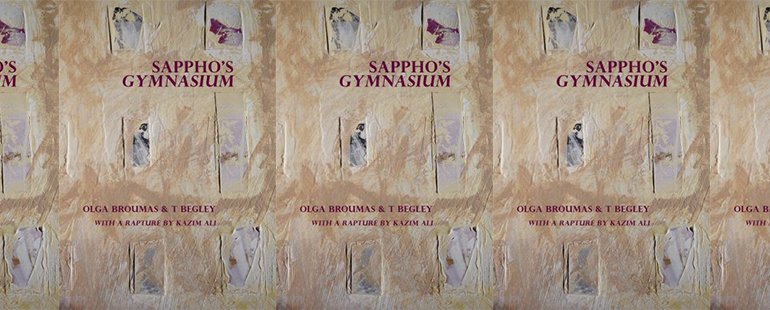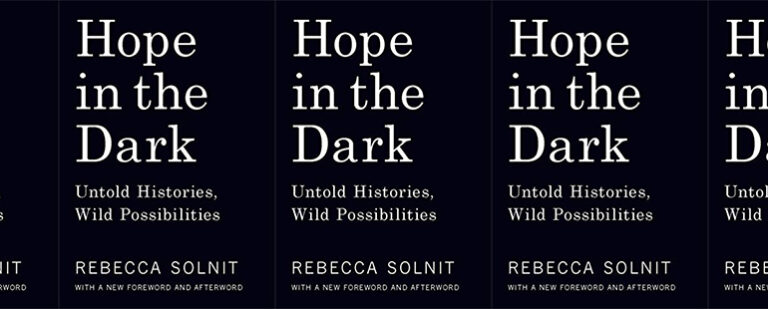Interconnection Beyond Denotation in Sappho’s Gymnasium

Olga Broumas and T Begley’s collaboratively written poetry collection Sappho’s Gymnasium plays with the planes of space and connection. According to the logic of these fragmented sapphics, the greater the open space to play in, the greater the possibilities for connection.
While poetry in general already tends to magnify what connection offers—the gifts of association between the vehicle and tenor of a metaphor, between images and insight, and between language’s sounds and meanings—Broumas and Begley go further in metaphysical experimentation and liberate the poetic line from the sentence. By eliminating this tether, the lines offer new vertices for connection.
With three editions published in 1994, 2000, and 2017, Sappho’s Gymnasium is a fluid, living performance inscribed on the page. Eros, spirituality, sensation, depth, and other themes spark throughout the book’s brief lyrics, but Sappho’s Gymnasium deals mostly in the business of defamiliarizing the poetic line’s very linearity. “Came to earth just earth and nothing else / then spirit was born clear easy guest / equal during exposure second,” they write. Within the line, we get the sensation that we could, at any moment, accelerate or reverse in either direction.
A similar sense of movement occurs across a stanza’s lines. In stanzas like “I stand in the dark / like photography beaming / the fruit measures itself / asking with my hands / yet more explicit / word with god,” a line such as “like photography beaming” could be grammatically connected to either the line before or the line after—or even open a new grammar where a line could be individually connected to both at the same time, invoking two meanings at once. This lyric becomes syntax-driven, and the possible connections are created through the fact that “like” is a preposition.
The 2017 edition of Sappho’s Gymnasium includes an extensive afterword-like “Rapture” written by Kazim Ali that examines just how the “grammar slips across the line” in “transit between material and spiritual.” Ali provides a reading of the text where eros and “utterance of the spirit must escape free.” He writes that the poets use “queer line breaks” to convey embodied, sensory physical and spiritual connection. Describing the relationship between language and ecstatic spirituality, so often evoked in our culture as “beyond words,” is one of the brilliant achievements of this book. For the reader, it feels that these words are beyond words: “Language you surge / language you try me / I set a place for you / who would have guessed there were so many / similars you with your light / plotted across my window / we are walking toward it art around / shoulder what else.” The end of this lyric falls apart as language’s “similars” surround the speaker(s).
The poets’ attempt to defy the poetic line’s very linearity and to generate connection and possibility helps articulate the ecstatic act of “soul rearing,” an expression of eros beyond “ideology” in which words, people, and spaces are interconnected beyond denotation. Their poems are typically composed of many pages’ worth of small groupings of lines in which the linguistic hooks that readers usually look for are smoothed over. Take, for instance, “Stunned a crimson flower sudden / but not surprising the sunny addiction / the barely possible thirst.” Perhaps “sudden / but not surprising” could be read as a single thought that reaches across the line break. The duo “the sunny addiction / the barely possible thirst” has something to do with longing, wanting. In “stunned a crimson flower,” however, there begins a sonic gesture that continues with “sudden,” “surprising,” and “sunny”; though “crimson flower” is technically an image, it’s uprooted, disconnected from the rest of the scene as we might expect to find it. The untethered eros of these lines is achieved through their grammar.
In the book’s opening poem, a piece I view as a compass to use when reading the rest of the book, the poets quote Wittgenstein: “The limits of my language mean the limits of my world.” If we usually think about a poem as a delineated space on the page, a blueprinted room for thought and image to reside in, Sappho’s Gymnasium seeks to remove these walls so the poems can wander (in the “Rapture,” Ali uses the word “rove”). “Wanderer gathers dusk in mountains / to its end the wind the stream / only riverbank hurry me // Only poetry.” Broumas and Begley seem often refer to poetry’s very essence as they experiment with stretching language until it tears like dough.
In “Your Sacred Idiot With Me,” the poets write, “Resting is possible / whose shock fills my mine / past once then the real.” In writing lines that don’t connect, with phrases like “my mine” and lines that end with noun-ified adjectives like “real,” the poets seem to want readers to focus on the poem’s space and movement rather than what the words actually mean. Denotation is deprioritized. When we boil the experience of language down to these elements without the distraction of denotation, new possibilities open up for sensing language anew. Only the embodied parts remain.
As with many experimental works, there can be comfort and clarity in this—“A soul I did insist upon / I live superimposed”—as well as fear and discomfort—“I didn’t cover myself / I looked instead right back // Art is climax over conduct / zen of no color by sunrise I do.” The poets and their poems seem aware of their allegiance to “climax over conduct,” intuition over grammar rules, a layer of this feminist, collaborative project in the spirit of its namesake, Sappho, in which two voices work together as one.


